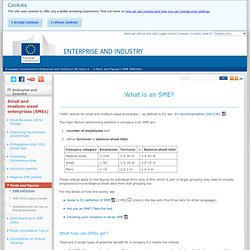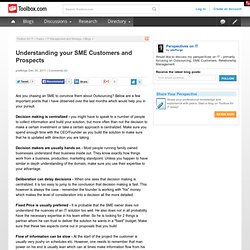

WHAT. What is an SME? - Small and medium sized enterprises (SME) - Enterprise and Industry. "SME" stands for small and medium-sized enterprises – as defined in EU law: EU recommendation 2003/361 The main factors determining whether a company is an SME are: number of employees and either turnover or balance sheet total.

These ceilings apply to the figures for individual firms only. A firm which is part of larger grouping may need to include employee/turnover/balance sheet data from that grouping too. For the details of how this works, see: What help can SMEs get? There are 2 broad types of potential benefit for a company if it meets the criteria: eligibility for support under many EU business-support programmes targeted specifically at companies of this size: E.g. research funding, competitiveness and innovation funding and similar national support programmes that could otherwise be banned as unfair government support ("state aid" – see block exemption regulation). External study on the implementation of the SME Definition (2012) SME's in Europe - facts and figures. The SME Performance Review is one of the main tools the European Commission uses to monitor and assess countries' progress in implementing the Small Business Act (SBA) on a yearly basis.

With an emphasis on the measures from the SBA Action Plan, the review brings comprehensive information on the performance of SMEs in EU Member States and other 9 partner countries. It consists of two parts – Annual Report on European SMEs and SBA country fact sheets. Brussels, 26 November 2013 - The European Commission published today the 2012/2013 Annual Report on European SMEs. The Report on European SMEs is prepared on a yearly basis. UK - SME facts and figures. The Department for Business, Innovation & Skills (BIS) collects and publishes national and official statistics on further and higher education, building materials, construction prices and costs, economic performance and employment, innovation and trade union membership.

National statistics We produce national and official statistics in accordance with the statutory and other arrangements described in the guidance on How national and official statistics are assured. We follow the code of practice for official statistics. The Code of Practice for Official Statistics requires that we announce publication dates for all statistical publications in advance. Publication dates for all BIS and HESA publications are available from the UK Statistics Authority Publication Hub. WHY. “No-one Understands Us”: Says SME Boss - Technorati Small Business.
Understanding An Entrepreneur. Video: What key characteristic defines an entrepreneur? What Makes An Entrepreneur Tick? - Entrepreneurialism. It is only natural that when you start a business, you are doing something different than most people.

They not only will look at you because you stick out like a sore thumb _ but human nature will cause people to naturally ridicule what you are doing. They will tell you all types of things like: "You're not business material. " "You can't make a living working for yourself. " "You'll fail because nobody can ever make any money that way. " Entrepreneurship is not just about having a lot of ideas or business sense. And if you have to start out small in building your self-confidence. But back to business _ when most people do fail in business they try to "save face" by telling everyone they are "just in a slump" and everything will be back to normal soon. The best thing to do for anybody in this catastrophe is to swallow their pride and admit they screwed up.
Understanding your SME Customers and Prospects. Are you chasing an SME to convince them about Outsourcing?

Below are a few important points that I have observed over the last months which would help you in your pursuit. Decision making is centralized - you might have to speak to a number of people to collect information and build your solution, but more often than not the decision to make a certain investment or take a certain approach is centralized. Make sure you spend enough time with the CEO/Founder as you build the solution to make sure that he is updated with direction you are taking Decision makers are usually hands on - Most people running family owned businesses understand their business inside out. They know exactly how things work from a business, production, marketing standpoint. Deliberation can delay decisions - When one sees that decision making is centralized, it is too easy to jump to the conclusion that decision making is fast.
Structured Updates vs. Types of business. An entrepreneur must also decide what type of business to establish.

There are three main types of small business. Each has a distinct form and structure. Sole trader A sole trader is a business owned by one person. Many plumbers, electricians, window cleaners and other trades people work in this way. Sole traders have complete control of their business they make their own decisions and take all the profits for themselves. A partnership This involves two or more people working together. From Bureaucratic Tech Transfer to Entrepreneurial Tech Commercialization by Norris F. Krueger, Brian Cummings, Steven Nichols. Norris F.

Krueger Jr. Entrepreneurship Northwest; Max Planck Institute for Economics Brian Cummings University of Utah Steven P. University of Texas at Austin - College of EngineeringOctober 23, 2008 Abstract: 60 university spinouts in 3 years. 94% still alive. We present an overview of the new University of Utah program where spinouts have skyrocketed (the stats above). Etzkowitz (2008) shows that despite the press and PR, the median TTO loses money - probably more than is usually known. We offer here a set of key principles for successful technology commercialization, illustrated by a very recent exemplar, that of the University of Utah.